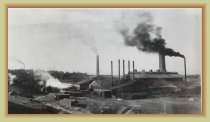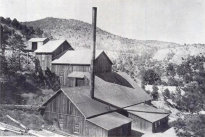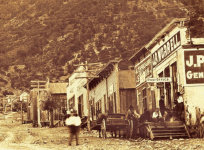On this page:
The Rosedale Mine and Mill
(Part 1: 1882–1913)
The 1891 built Rosedale mill as it appeared in 1905. The gravity fed mill sent ore to a steam driven stamp mill for crushing the ore
and an amalgamation table, and later the cyanide plant, for the gold recovery. This mill was destroyed by fire on August 12, 1910
and rebuilt. More photos
here.
Photo: NM Bureau of Geology and Mineral Resources
1882–1903
The Early Days. In 1882, Jack Richardson, and wife Lydia "Rose" Richardson, discovered gold in a rhyolite outcropping in
the San Mateo mountains. Due to hostilities in the area by a band of Apache, it was not until 1886 that Richardson was
able to develop his claim in earnest.
At first he worked the vein on the surface and shipped ore to the Colorado
Smelter Co. in Pueblo, Colorado for processing, immediately realizing a profit. By 1888, the surface ore
was depleted. Richardson and some workers from the Kelly mining camp drove an adit into the mountain to intercept the vein. Working
the lode, they realized the vein, ranging from four to 10 feet wide, ran nearly vertical. This necessitated building
a shaft parallel to the vein for access. By 1889, the shaft was sunk to 50 feet with a crosscut, extended to 150 feet with
several drifts to access the vein by 1890.
During the early 1890s, Richardson's gold mine was making him and some investors respectable
money. Mining news was big news at this time. Yet, almost nothing is written of the Rosedale mine in newspapers during
this period. It is not known if the "secret" of the mine was intentional or just the low profile of Richardson's character.

Mine ownership became somewhat confusing 1905-1909 as ownership of the mine and mill changed hands several times.
The W. H. Martin Co. sold the mine to Kelly merchant Jonathan P. Worrell and George Dix of Indiana in 1905, operating under the nameRosedale Gold Mining Co. The Martin Co. retained ownership of the mill. A year later, the Martin Co. purchased
the Rothchild and Great London claims, including the mill site, from the original claimants, Jack and Lydia Richardson.
In 1909, the mine and mill became privately owned by the W.H. Martin Co. The new enterprise was called the Rosedale Mining and
Milling Co. with principal owner Jonathan Worrell as president. The new company reported 1,400 troy ounces of gold produced
in their first year of operation, a revenue of about $29,000.
A 1909 Socorro Chieftain newspaper reported:
1891 – Stamp Mill. Richardson built a gravity fed stamp mill near the mine shaft consisting of two rock crushers and a
10-stamp battery, with 850-pound stamps, for fine crushing the gold ore. He hired C.H. Wilkie, a renown mining and
milling engineer from the Mogollon mines to build the Rosedale mill. Operations began in August 1891; Wilkie returned
to Mogollon and R.W. Williams was hired as the engineer, running the mill at 50 tons per day capacity.
The stamp mill
crushed the ore to nearly a powder with the gold ore
concentrate extracted on a "shaker table." This method recovered the
metalic gold from the rock, though left small pieces of gold in the mill waste. By shipping gold concentrate from
the mill to the smelter in Colorado, instead of raw ore, yielded a higher value per ton for increased profits. The first
gold was returned from the smelter in December 1891 – 242 ounces of gold bullion, at $20.67 per ounce, with a value of about $5,000
(about $200,000 today).
The word of Richardson's profitable mill, built with company profits – not investor money,
quickly spread and brought the Rosedale mine out of obscurity. Soon, there were prospectors crawling all over the area staking
claims (few were successful). News suddenly filled the region's newspapers putting Rosedale on the map.
In 1893, San Marcial
merchant C.H. Featherston became a 1/4th owner of the mine with a $600 investment (about $24,000 today). Mining news in
the Socorro Chieftain and Santa Fe New Mexican, some penned by Featherston, report the ongoing success of the Rosedale mine
and the handsome returns on some of their shipments to the smelter.
1896 – Change in Ownership. In 1896, the mine was operated
and incorporated under the name "W.H. Martin Co.," a mining brokerage firm for the purposes of selling mining stocks. Initial
offering was 50,000 $1 shares. W.H. Martin Co. owned, partially owned, and operated mines and mills all over the west.
Richardson remained a controlling partner and continued to run the operation. In 1898, Richardson sold his
interest for $160,000 (about $5 million today), giving the W.H. Martin Co. near full control of the mine and mill. It was
often called the "Martin-Rosedale mine" during this period.
1899 - a cyanide plant was built under the new ownership for
increased recovery of the gold ore. A plume was built to transfer the slurry to the settling ponds. An assay lab, lumber
mill, carpenter shop and blacksmith shop were also built to support the expanding enterprise. A 3-mile long steel pipeline was
built, bringing 2,000 gallons a day to the mill and cyanide plant from Seven Springs, south of the mine.
Regardless, ore wagons left Rosedale once a week for the railhead at Magdalena for shipping the ores to the Colorado Smelting Company in Pueblo, Colorado. Ore's valued about $12 per ton was considered the "break even" point for raw gold ore (receiving no or little preprocessing or concentration). The Rosedale ores were averaging $20 to $40 per ton for consistent handsome profits, though no one seemed to yet notice.
The Colorado Smelting Co. in Pueblo, Colorado operated eight blast furnaces and 20 kilns for processing gold, silver, iron, and other ores from area mines.
The cyanide plant required 4-5 cords of wood, 13 pounds of cyanide, three pounds of zinc and other materials every 24 hours.
The sodium cyanide was purchased from the Denver Fire Clay Co. for $24 per 100 pounds.
1901 Fire. In March 1901, a fire
burned the assay office and lab building. The mill was not damaged. However, the fire destroyed all company records — the reason
there is so little information on shipments, amount of gold mined, employees, etc. prior to 1901. With the loss of records, there
appears to have been a land ownership dispute forcing the mine to close for periods. This was eventually settled when a mine
patent was awarded to the W.H. Martin Co., effective to 1901.
1910 Fire. Richardson's 1891 built stamp mill, plus the 1903 expansion by the W.H. Martin Co., burned to the ground in August
1910 with $75,000 in losses. The miners were put to work rebuilding the mill. The company owned saw mill provided most of the lumber
and wood for the rebuild. W.H. Martin Co. announced the temporary cessation of all mining activities – and dividend payments
– until the completion of the new mill. This upset investors, many whom sold their stocks, the stock value crashed, which
placed the company in financial distress trying to rebuild the stamp mill.
The Aug. 11, 1910 Santa Fe New Mexican describes
the Rosedale mill fire:
The Socorro Chieftain article on the Rosedale fire explains how Dr. McCreary of Magdalena was rushed to the mining camp by
automobile as soon as he was summoned to treat Mr. Everhart's wounds.
1913. It was not until 1913 that the new mill was completed
and the mine resumed operations and profitability. It is not known why it took two years to rebuild the mill. Without the stamp
mill, raw ore was sent to the ASARCO smelter, at increased costs, to maintain production. When the mill reopened in 1913, the
company converted from the oxen wagon teams to gasoline powered trucks for hauling ore to the railyards at San Marcial.
Rosedale Mine
33.8089°N 107.4061°W Elev. 7250 ft. ASL
1903 Mine Renovation. During much of 1903, the mine and mill was closed while a crew of 30 installed new machinery, expanded
to a 20-stamp mill, and electrified the facilities. Large pumps were installed in the mine to pump down the water in the
shaft at the 736 foot level, though this proved unsuccessful. A new larger shaft hoist was installed with a higher tonnage
capability.
The Power Plant for the mine was a wood fired boiler and reciprocating steam engines for powering the belt
driven machinery. The mine was electrified in 1903 replacing the steam plant with two gasoline engines driving 450
volt generators for the new mill machinery, electric lighting in the mill buildings and mine, and a Worthington air compressor
for supplying air ventilation in the mine. A Sullivan compressor was also installed that supplied low pressure air for
the cyanide plant agitators.
The mine returned to full operation in September 1903 to begin processing the rich ore
found on the 8th and 9th levels. The gold ore concentrates from the renovated stamp mill and cyanide plant were assayed
as high as $4,000 per ton. The gold ore was now being shipped to San Marcial by wagons. The Colorado Smelting Co. in Pueblo,
Colorado had merged with the American Smelting and Refining Co. (ASARCO) in 1899. ASARCO had requested the Rosedale ore
be shipped to their new smelters in El Paso, Texas instead of Colorado. Shipping rail charges were less from San Marcial
than Magdalena.
Links:
Socorro County Historical Society
Socorro, New Mexico, USA
History
Articles
Rosedale and the Rosedale Mines
Mines3
2
Rosedale Area Mines
Click on mine name for more information
Co-owner C.H. Featherston reported the Martin-Rosedale mine had produced over $90,000 in gold by February 1901. A few
months later, in May, a bonanza strike was reported at the 500-600 foot levels where a 10-foot wide gold laden quartz vein was
discovered. The next month, the ore crusher failed, closing the mill for over a month until repaired. During this time,
the shaft was bore to 736 feet deep where they hit water. In November, severe winter snows and frigid temperatures closed
the mine on-and-off until April 1902. Anxious to get back to work on the bonanza lode, building a smelter was being considered, though
never built.
Jonathan P. Worrell was a medical doctor and lived in Terre Haute, Indiana. He built the J.P. Worrell store in Kelly and a co-owner of the Graphic Mine, in addition to his interests in the Rosedale mine.
Photo: SCHS archives
"J.P. Worrell of Indiana is the
principal owner of the Rosedale
mine; L.R. Babcock, of Kelly, is the
general manager; J.J. McInnis is
in charge
of the mill and engine
room. The mill just shipped it's
monthly gold brick to the
mint at
New Orleans, worth between
$4,000 to $5,000. The mill now
has 20-stamps and employs 40
men."
Even at $4,000 per monthly shipment, the mine was now deliverying at least $48,000
worth of gold bullion to the U.S. mint annually ($1 million today).


Preserving and archiving Socorro County history
WAGES PAID AT ROSEDALE MINE
Ref.: 1910 Mining Report, Professional Paper #68
MINE
Foreman $4.00/day
Lumberman $3.00
Miners (5) $2.00
Trammers (2) $3.00
Hoistman
$3.50
STAMP MILL
Foreman $3.00/day
Helper $1.50
Fireman $1.50
Crusher
Boy $1.00
Carpenter $3.00
CYANIDE PLANT
Foreman $5.00/day
Filterman
$3.00
Lander Boy $1.50
SHIFT & DAILY TOTALS
Mine $23.50/shift x2 shifts/day
Stamp
Mill $10.00/shift x2 shifts/day
Cyanide Plant $ 9.50/shift x1 shift/day
TOTALS
$43.00/shift
$76.50/day (about
$2,050/day today)
There were two 9-hour shifts per day in the mine and stamp mill
and one 9-10 hour shift in the cyanide plant (daylight hours only)
Mines3
0920/19


